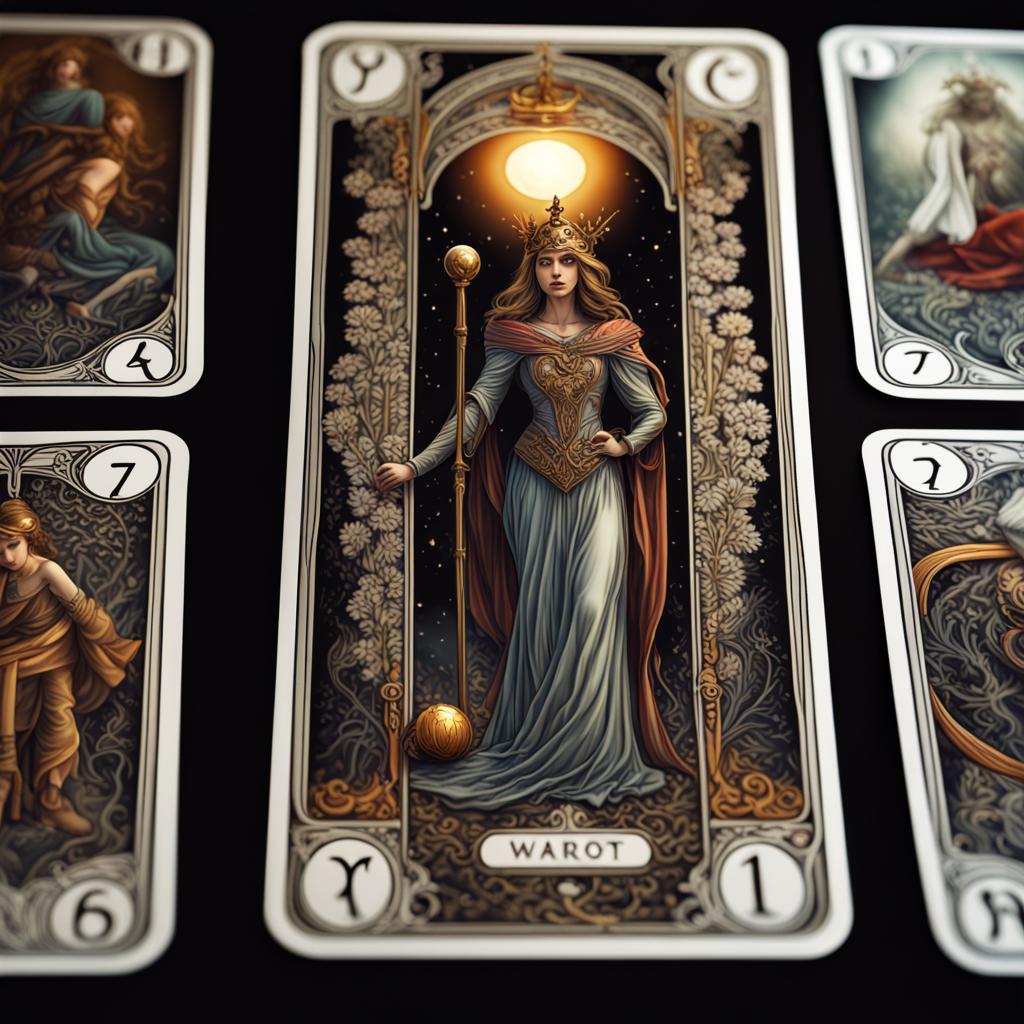Tarot card history

Tarot Cards: Unveiling History Unveiling the Enigmatic History of Tarot Cards A journey into the mysterious origins and enduring legacy of Tarot Cards Origins and Ancient Roots: Tracing the History of Tarot Cards As one of the most popular and enduring systems of divination, tarot cards have fascinated people for centuries. With their rich symbolism and mystical allure, tarot cards have been used to uncover hidden truths, gain insight, and explore the depths of the human psyche. But where did these intriguing cards first originate? Let's delve into the ancient roots and trace the captivating history of tarot cards. The Birth of Tarot: From Playing Cards to Divination Tools The exact origins of tarot cards remain shrouded in mystery, but they are believed to have emerged in Europe during the late 14th century. Originally, tarot cards were not intended for divination; rather, they functioned as playing cards in popular card games of the time. The earliest surviving deck, known as the Visconti-Sforza tarot, dates back to the 15th century and was commissioned by the ruling families of Italy. It wasn't until the 18th century that tarot cards started evolving into tools for divination and occult practices. Prominent occultists, such as Antoine Court de Gébelin and Jean-Baptiste Alliette (better known as Etteilla), introduced the concept of using tarot cards for fortune-telling. They believed that the symbolism and archetypal imagery within the cards held deep esoteric meanings that could unlock spiritual knowledge and provide guidance. The Mystical Influence of the Hermetic Order of the Golden Dawn The late 19th century witnessed a significant turning point in the history of tarot cards. The emergence of the Hermetic Order of the Golden Dawn, a secret society dedicated to the study and practice of the occult, played a pivotal role in popularizing tarot as a tool for divination and personal growth. Influential figures within the order, such as Arthur Edward Waite and Pamela Colman Smith, collaborated to create the now-famous Rider-Waite-Smith tarot deck. The Rider-Waite-Smith deck, first published in 1910, introduced revolutionary changes to tarot card imagery. It featured detailed illustrations for each card, incorporating a vibrant color palette and symbolic elements that resonated with a wide range of readers. This deck went on to become the most influential and widely used tarot deck in the Western world. The Modern Revival and Ever-Growing Popularity Throughout the 20th century, tarot cards gained momentum as a tool for self-reflection, guidance, and spiritual exploration. The symbolism within the cards appealed to individuals seeking personal insight and a deeper understanding of themselves and the world around them. The accessibility of tarot was also enhanced by the publication of numerous books, guidebooks, and instructional materials that introduced readers to different tarot systems and interpretations. Today, tarot cards continue to captivate and inspire people from all walks of life. The advent of the internet and digital platforms has further broadened the reach of tarot, allowing enthusiasts to connect, learn, and explore tarot symbolism and meanings online. Tarot has become a versatile tool for personal development, intuition development, and a source of spiritual guidance in our modern, fast-paced world. In conclusion, the history of tarot cards is a fascinating journey that spans centuries. From humble origins as playing cards to powerful tools for divination and self-discovery, tarot cards have evolved and influenced countless individuals along the way. Whether you view tarot as mere entertainment or a profound tool for transformation, there is no denying the enduring allure and rich history behind these iconic cards. Evolution and Symbolism: How Tarot Cards Transformed through the Ages Tarot cards have a long and fascinating history that spans several centuries. From their origins as playing cards in the late 14th century to their current use as a tool for divination and self-reflection, the evolution of tarot cards is a testament to the enduring power of symbolism. Origins of Tarot Cards The exact origins of tarot cards are unclear and often debated among historians. However, it is widely believed that they originated in the 14th century in Europe, specifically in Italy or France. Originally, tarot cards were used for playing card games similar to modern-day bridge or poker. The earliest surviving tarot decks, such as the Visconti-Sforza tarot deck, were richly decorated and featured intricate hand-painted images depicting various subjects including biblical themes, mythological figures, and everyday life. These images became the foundation for the rich symbolism that characterizes tarot cards today. Transformation into a Divination Tool It wasn't until the late 18th century that tarot cards began to be used for divination and occult purposes. This transformation can be largely attributed to the work of French occultist Jean-Baptiste Alliette, also known as Etteilla. Alliette published the first comprehensive guide to using tarot cards for divination, introducing new interpretations and meanings for each card. Throughout the 19th and 20th centuries, various esoteric and occult movements further popularized the use of tarot cards as a tool for spiritual guidance and self-reflection. The influential Golden Dawn society, founded in the late 19th century, developed a systematic approach to tarot interpretation that is still widely used today. Symbols and Meanings One of the most intriguing aspects of tarot cards is the wealth of symbols and imagery they contain. Each card in a tarot deck has a specific meaning and symbolism attached to it. These symbols can vary depending on the specific deck, but many tarot decks share common themes and archetypes. The Major Arcana, a set of 22 cards considered the core of a tarot deck, represents significant life events or stages of personal development. Each card in the Major Arcana is associated with a unique symbol and meaning, such as The Fool representing new beginnings and The Tower symbolizing sudden upheaval and change. The Minor Arcana, consisting of four suits (Swords, Cups, Wands, and Pentacles), reflects more mundane aspects of everyday life. The symbols in the Minor Arcana cards often depict emotions, relationships, challenges, and material concerns. Modern Interpretations In recent decades, there has been a resurgence of interest in tarot cards, with numerous artists and designers creating their own unique interpretations of the traditional deck. This has led to a diverse range of tarot decks featuring various art styles, themes, and symbolism. Modern interpretations of tarot cards often emphasize personal growth, spiritual development, and self-reflection. Many people use tarot cards as a tool for introspection, seeking guidance and insights into their lives and decision-making processes. Conclusion The evolution of tarot cards throughout history is a testament to their enduring appeal and symbolism. From their humble beginnings as playing cards to their present-day use as a tool for divination and self-reflection, tarot cards continue to captivate and inspire people across cultures and generations. Modern Interpretations and Popular Practices: Tarot Cards in the Contemporary World The history and origins of tarot cards can be traced back several centuries, from their humble beginnings as playing cards in the 15th century to becoming established as a tool for divination and self-reflection in the 18th century. However, it is in the contemporary world that tarot cards have seen a surge in popularity and embraced by a diverse range of individuals seeking guidance, insight, and personal growth. One of the reasons for the enduring popularity of tarot cards today is their ability to adapt and evolve with the times. While traditional tarot decks like the Rider-Waite-Smith and the Marseille Tarot remain widely used and cherished, modern interpretations of tarot have emerged, catering to the changing needs and interests of individuals. Contemporary tarot decks often feature updated artwork, innovative themes, and alternative interpretations of the tarot archetypes. This allows individuals to resonate with the cards in a way that feels more relevant and relatable to their own lives, making the practice of reading tarot more accessible and inclusive. Moreover, tarot cards have found their place in various spheres of popular culture, further contributing to their modern-day appeal. They have become a regular feature in movies, television shows, and literature, often portrayed as a mystical and mysterious tool that holds the key to unlocking hidden truths. The understanding of tarot cards has evolved beyond mere fortune-telling, with many practitioners embracing them as a means of self-reflection, personal growth, and spiritual development. Modern interpretations encourage users to approach tarot as a tool for introspection and understanding, empowering individuals to gain insights into their own thoughts, feelings, and desires. Additionally, the digital age has facilitated the accessibility and popularity of tarot readings. Nowadays, tarot apps and online platforms provide users with instant access to tarot readings or enable them to learn and practice tarot on their own. This convenience has further broadened the reach of tarot, attracting a wider audience and fostering a global community of tarot enthusiasts. It is important to note that tarot cards should always be approached with respect and caution. While they can provide valuable guidance and inspiration, it is ultimately up to the individual to interpret and apply the messages received. Tarot cards are a tool that can assist in self-discovery, but they should never be seen as a definitive answer or substitute for personal agency. As tarot cards continue to gain popularity in the contemporary world, their timeless wisdom and captivating symbolism ensure that they remain relevant in an ever-changing society. Whether used for divination, personal growth, or as a source of artistic inspiration, tarot cards continue to captivate and enthrall individuals, inviting them to embark on a unique journey of self-exploration and enlightenment.
